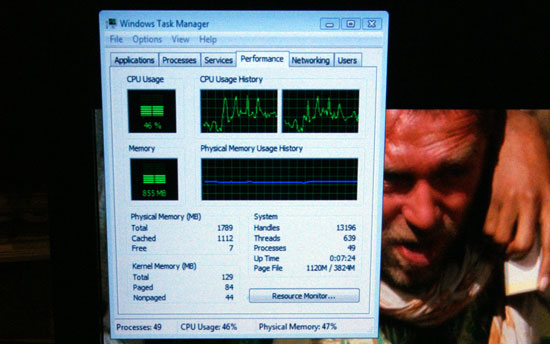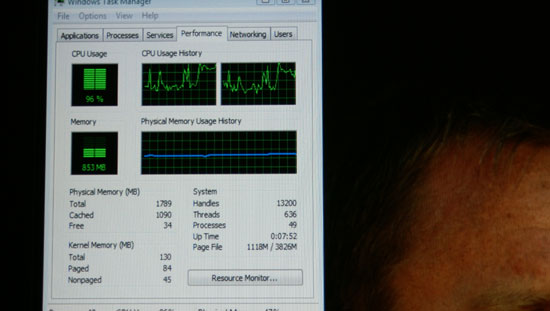NVIDIA's Ion Platform: Performance Preview
by Anand Lal Shimpi on February 3, 2009 9:01 AM EST- Posted in
- GPUs
Blu-ray Playback: The Big Feature
Intel’s US15 chipset (codenamed Poulsbo) supports full hardware MPEG-2, VC-1 and H.264 decode acceleration. It’s necessary because Atom is too slow to decode high bitrate video encoded in these formats. Without this hardware decode acceleration, Atom wouldn’t be able to playback Blu-ray or HD video.
Most desktops, notebooks and netbooks based on Atom don’t use the US15 chipset; they use 945G and 945G lacks this hardware decode acceleration support.
NVIDIA’s GeForce 9400M addresses the problem using its PureVideo HD engine, providing support for full hardware decode acceleration of all three of the aforementioned codecs. In other words, you should be able to watch Blu-ray movies on an Ion based PC.
On a Core 2 Duo machine, CPU utilization will be in the single digits (double digits for a single core) while playing a Blu-ray movie on a GeForce 9400 motherboard. Despite the hardware accelerated video decode, the initial handling of the data to be decoded is still done on the CPU. Not to mention that getting the encrypted data off of the disc and decrypting it also happens on the CPU. As important as the GPU is in this situation, you still need a fast CPU to watch a Blu-ray movie. But a fast CPU, the Atom processor is not.
Would the 9400M be enough to let you watch a real Blu-ray movie on an Atom based machine?
NVIDIA included a clip from The Dark Knight Blu-ray on the Ion system’s hard drive for us to test CPU utilization. No thanks. As much as we trust NVIDIA to have selected the most balanced content representative of all Blu-ray movies, and included it on the hard drive it shipped with the Ion reference platform, we thought we’d stick with our own content.

Blu-ray Casino Royale on an Ion
We took our Casino Royale Blu-ray disc and ran it through AnyDVD HD. We ripped the disc and copied the resulting ~46GB ISO to the Ion’s hard drive. We didn’t have an external Blu-ray drive so this was the best method of being able to watch a Blu-ray on the machine.
As expected, hardware acceleration worked. Casino Royale was encoded in H.264 and the Ion platform decoded it flawlessly. CPU utilization was high averaging between 40 - 50% on a single-core Atom machine with Hyper-Threading enabled:

There were some scenes where the CPU utilization peaked to over 90%. While we didn’t see any dropped frames, keep in mind that we’ve already decrypted the disc; the CPU is actually doing less here than if we were playing a Blu-ray disc directly from a drive. I suspect that playing back encrypted content it is possible for the Ion platform to drop frames if CPU utilization jumps out of its comfortable 40 - 50% average.

It’s worth mentioning that the Ion machine rarely jumped up that high in CPU utilization, but it definitely did at a few points while playing Casino Royale. A standard Atom platform with the 945G chipset couldn’t even attempt to play a Blu-ray movie. While there may be some cause for concern that Atom, even paired with the 9400M, won’t always be enough to watch Blu-ray movies on it’s too early to tell. At worst I wouldn’t expect to drop more than a few frames every now and then based on how often I saw the CPU spike above 90% utilization.
I tried enabling both cores on the Atom processor (NVIDIA shipped the Ion reference with a dual-core Atom 330, but with one core disabled) to see if that could alleviate the CPU utilization concerns. Unfortunately I seemed to have run into an NVIDIA or Cyberlink software issue because I couldn’t get smooth Blu-ray playback on Ion with both cores enabled on the Atom 330.










69 Comments
View All Comments
chizow - Tuesday, February 3, 2009 - link
Certainly getting ahead of myself a bit, but I wouldn't be shocked if Nvidia starts moving in this direction with a low-cost, decent performing fixed hardware PC gaming platform. All you'd need is slightly faster CPU and GPU, throw in a cheap GPU for dedicated PhysX.The ability to web-surf and play Blu-Ray back on a small platform is certainly interesting though. I agree they'll need to improve the aesthetics a bit on the housing, but for $200-300, the same price as a stand-alone Blu-Ray player, the Ion would certainly be a compelling option.
I think some of the road blocks would be the Blu-Ray drive itself, whether you could actually play Blu-Ray media. Relying on streaming or ripped copies would make the tech much less appealing. Also, how about outputs? Is the Ion able to output 8ch LPCM or lossless bitstreams like DTS-HD or TrueHD? Anyways, looks interesting for sure and certainly a nice alternative to Intel's gimpy Atom chipset/platform.
JimmiG - Tuesday, February 3, 2009 - link
To be honest, I don't think a more powerful GPU would have changed the way I use my Aspire One netbook.There's no need to be able to watch blu-ray movies, because lower resolution DivX etc. looks just as good on the 8.9” screen, and you can store a lot more of it locally (the system obviously lacks an optical drive).
As for games, I might have installed a couple of games just for fun to see how awful they run. But I would quickly grow bored with them. Why play games at the lowest settings at 800x600 on a tiny screen using a mini-keyboard and at best a flimsy laptop mouse, when I've got a 22” monitor hooked up to a quad-core machine with 4850 graphics in the other room? If I was serious about playing games on the move, I would have skipped my desktop system altogether and bought a gaming notebook.
It might be somewhat useful as a HTPC. The usefulness of the EeeBox in such a setting was severely limited by the poor graphics performance. On the other hand, you could just as easily get a small, stylish u-ATX case and build something around a cheap Athlon X2 or low-end Core2 Duo/Pentium Dual Core. With a PCI-E x16 slot, you could even install a decent videocard (4830) and not only use the system to play HD video, but also play the latest games on the living room TV. The system would only be slightly larger and hardly louder, but the cost would be about the same and you'd get a much more flexible system,
cosmotic - Tuesday, February 3, 2009 - link
How about older games with potentially playable frame rates like Quake3, Warcraft3, and maybe even UT2004?cosmotic - Tuesday, February 3, 2009 - link
I think you are confusing CODECs with compression algorithms. The CODEC you are using in these tests is Cyberlink's h.264 CODEC which is a) tightly coupled to Cyberlink's super-crappy player, and b) (and im guessing here) only available in Cyberlink's super-crappy player. This isn't unexpected considering basically every other hardware accelerated decoder works the same way. However, I really wish that hardware decoder manufactueres would realize that it would be worlds more useful to users for their chips to ship with Generic DirectShow h.264 CODECs which could be used in ANY DirectShow based program.Please Anand, tell me I'm wrong and that the Cyberlink Player is actually running off of a DirectShow CODEC which is available to any other application!!! (in which case, why are you using that crap software?)
BikeDude - Tuesday, February 3, 2009 - link
I would like to know the same thing myself. (I am certainly no Cyberlink fan -- they have a buggy codebase mixed with terrible support)Also: Is the PureVideo codec payware, or will this thing come with it bundled? (I assume PureVideo HD _is_ DirectShow)
cosmotic - Tuesday, February 3, 2009 - link
Last I checked, PureVideo is a player using it's own CODEC. I think it's up to the OEM to pay to include it with their cards and I dont think any of them do, or if they do, they include what amount to 'lite' versions of old versions. I'm guessing nVidia decided to forgo maintaining their own player and just let Cyberlink handle all that. Even their website says to buy PowerDVD instead of PureVideo if you're running vista.QChronoD - Tuesday, February 3, 2009 - link
So the Ion won't do decoding on the graphics chip if you are playing a random .mkv through VLC???apanloco - Tuesday, February 3, 2009 - link
That's correct. It won't.sprockkets - Wednesday, February 4, 2009 - link
I've played 720p content on a dual core atom platform with VLC, but it works only if you turn off the deblocking of h264, which kills most of what makes h264 look so nice. Forget about 1080p.xRyanCat - Tuesday, February 3, 2009 - link
PureVideo is just marketing lingo for GPU accelerated video. All cards from 6600GT and up (I have a 6600GT, but it might apply to earlier cards) can offload a certain amount of CPU load to the GPU. With a 6600GT and an Athlon 64 3200+ (@2.5GHz) a 1080p video results in about 60%-80% constant CPU usage. Without GPU acceleration even 720p videos are unplayable. And VLC supports offsetting load to the GPU on Linux and Windows platforms. I know gXine also has the same support on Linux.I can't see why it wouldn't work.